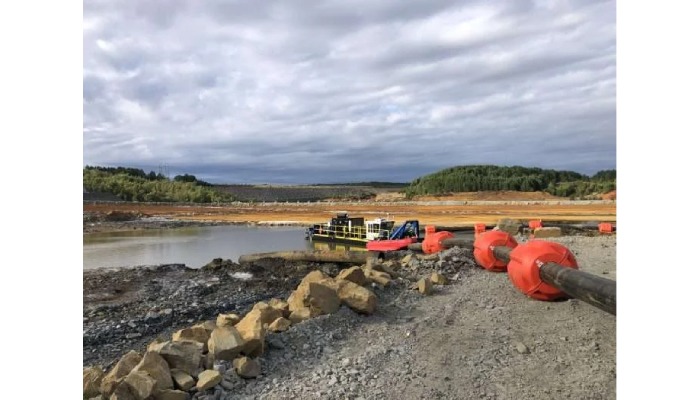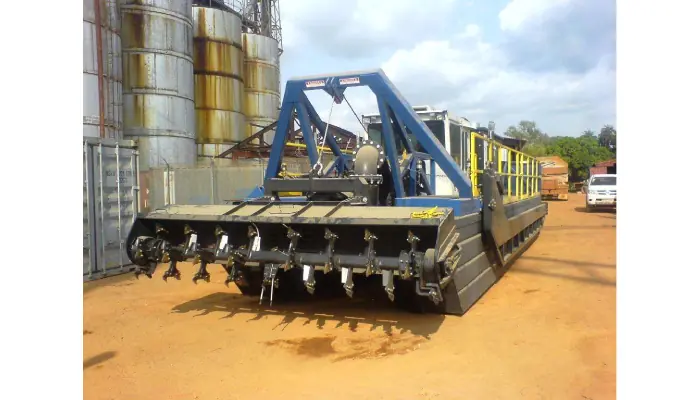
In 2025, mining companies should focus on several key strategies to improve their tailings pond dredging efforts. First, they could really benefit from adopting advanced technologies like drone surveys for monitoring and automated systems for greater efficiency. Sustainable practices are also crucial; using energy-efficient equipment helps reduce carbon footprints while recycling materials from tailings is smart too. Proper risk assessment and comprehensive safety management are necessary to prevent any potential failures, while staying aligned with evolving regulations is a must. Finally, engaging with local communities fosters trust and transparency, enabling better decision-making and ensuring a cooperative approach to these operations.
1. Adoption of Advanced Technologies in Dredging
The adoption of advanced technologies in dredging is crucial for optimizing efficiency and safety in mine tailings dredge pond management. Utilizing drone surveys and remote sensing allows for precise monitoring of tailings pond conditions, enabling operators to quickly identify changes in structure or composition. For instance, drones can capture high-resolution images that help assess the health of the pond’s banks and surrounding environment.
Automated dredging systems are another breakthrough, minimizing human error and enhancing operational efficiency. These systems can be programmed to execute specific tasks, such as adjusting the depth of dredging based on real-time data. By leveraging technologies like machine learning and artificial intelligence, dredging operations can become more responsive to immediate environmental conditions, ultimately leading to safer and more sustainable practices in mining.

2. Implementing Sustainable Practices for Tailings
Sustainable practices in tailings management are essential for minimizing environmental impacts and promoting responsible mining. One effective approach is to focus on energy-efficient equipment during dredging operations. By using machinery that consumes less fuel and generates fewer emissions, companies can significantly reduce their carbon footprint. For instance, electric dredgers or hybrid systems can replace traditional diesel-powered equipment, leading to cleaner operations.
Another key strategy is the incorporation of waste recycling methods. This involves repurposing materials extracted from tailings, such as using fine particles in construction or as fillers in various industrial processes. By finding new uses for these materials, mining companies can help divert waste from landfills and lessen the environmental burden.
3. Comprehensive Risk Assessment and Management
Effective risk assessment and management are crucial in ensuring the safety and sustainability of tailings pond dredging operations. Mining companies should establish a comprehensive risk management framework that identifies potential hazards associated with tailings storage facilities. Regular stability assessments and geotechnical evaluations should be conducted to monitor the integrity of these structures. For instance, companies can use advanced modeling techniques to predict potential failure scenarios and develop mitigation strategies accordingly.
Additionally, companies must engage in continuous monitoring to detect any changes in the physical state of the tailings. This can include using sensors and real-time data to track shifts in the pond’s structure or water levels. By assessing risks proactively, mining operations can not only protect their assets but also safeguard the environment and nearby communities. Creating a culture of safety that prioritizes risk management can significantly reduce the likelihood of catastrophic events, ultimately enhancing the overall effectiveness of dredging operations.
4. Ensuring Regulatory Compliance and Best Practices
Regulatory compliance is crucial for the safe and responsible management of mine tailings ponds. As regulations continuously evolve, mining companies must stay informed about the latest requirements and industry standards regarding tailings management. Engaging with regulatory bodies helps ensure that operations not only meet but exceed safety and environmental guidelines. For instance, companies can participate in workshops and conferences hosted by regulatory agencies to better understand compliance expectations.
Best practices in tailings management also play a significant role. This includes conducting regular audits of tailings facilities to ensure they adhere to established protocols. Additionally, implementing a transparent reporting system can foster trust among stakeholders by openly sharing compliance data and operational practices. Companies like Barrick Gold have demonstrated the effectiveness of these strategies by actively collaborating with local authorities to enhance their tailings management practices, ultimately leading to improved safety and community relations.
5. Community Engagement and Communication Strategies
Effective community engagement is crucial for the success of mine tailings pond dredging operations. Mining companies should prioritize clear and open communication with local communities to discuss their strategies for managing tailings. This includes informing residents about safety measures, potential risks, and the benefits of dredging projects. For instance, hosting community meetings or workshops can provide a platform for sharing information and addressing concerns directly. Additionally, involving community stakeholders in decision-making processes fosters trust and transparency. When locals feel their voices are heard, they are more likely to support mining activities. Companies can also utilize social media and other communication channels to keep the community updated on progress and any changes in operations. By establishing a two-way communication channel, mining companies can build strong relationships with the community, ensuring that both parties work collaboratively towards common goals.
6. Investing in Research and Development
Investing in research and development (R&D) is crucial for advancing dredging techniques and materials in mining. By focusing on innovative solutions, companies can reduce the environmental impact of their operations. For instance, developing biodegradable dredging materials could lessen pollution and improve sustainability. Collaborating with universities and research institutions can bring fresh perspectives and cutting-edge methodologies to the table. These partnerships can lead to breakthroughs in dredging technology, such as more efficient sediment removal processes or enhanced methods for assessing tailings pond safety. Companies that prioritize R&D will not only stay ahead of regulatory requirements but also position themselves as leaders in responsible mining practices.
7. Opportunities for Tailings Reprocessing
Exploring opportunities for reprocessing tailings is becoming increasingly important in the mining industry. By recovering valuable minerals from tailings, companies can not only reduce waste volumes but also generate additional revenue. For example, technologies that enable the extraction of metals like gold, copper, and rare earth elements from old tailings can transform what was once considered waste into profitable resources. This reprocessing not only mitigates environmental risks associated with large tailings ponds but also aligns with the global push for sustainability. Additionally, advancements in hydrometallurgy and bioleaching are making it economically viable to extract metals that were previously too costly to recover. Companies that invest in these reprocessing technologies can gain a competitive edge while contributing to a circular economy.
8. Effective Monitoring and Reporting Systems
Setting up effective monitoring and reporting systems is crucial for the success of mine tailings pond dredging operations. Utilizing real-time monitoring technologies allows teams to gather data on environmental conditions and the structural integrity of tailings ponds continuously. For instance, sensors can track water levels, sediment displacement, and potential leaks, providing immediate alerts to operators. This proactive approach not only enhances safety but also helps in making informed decisions quickly.
Moreover, transparent reporting mechanisms are essential for accountability. Mining companies should share monitoring data with stakeholders, including local communities and regulatory bodies. This could involve creating accessible online platforms where interested parties can view real-time data and reports. Such transparency fosters trust and demonstrates a commitment to responsible management of tailings.
Integrating both monitoring and reporting systems into a cohesive framework is vital. This can be achieved through software that compiles data from various sources, analyzes trends, and produces reports that are easy to understand. For example, a dashboard displaying key performance indicators can help decision-makers assess the effectiveness of dredging operations at a glance.
9. Training and Workforce Development Initiatives
Training is crucial for the success of dredging operations in the mining sector. As technology evolves, the workforce must be equipped with the latest knowledge and skills. Companies should implement regular training sessions focusing on new technologies, such as automated dredging systems and advanced monitoring tools. For example, workshops on drone usage for tailings pond surveillance can greatly enhance operational efficiency.
Promoting a culture of safety and environmental responsibility is equally important. This can be achieved through safety drills and educational programs that emphasize the significance of proper tailings management. By fostering an environment where employees are aware of their roles in maintaining safety standards, companies can significantly reduce the risk of accidents. Furthermore, mentorship programs that pair experienced workers with newer employees can facilitate knowledge transfer and enhance overall workforce competency.
10. Emergency Preparedness and Response Planning
Emergency preparedness is crucial in the mining industry, especially regarding tailings pond dredging. Mining companies must develop thorough emergency response plans that address potential failures in tailings dams. These plans should be regularly updated to reflect new risks and industry best practices.
Conducting drills and simulations is essential for ensuring that the workforce is ready to respond effectively in various emergency scenarios. For example, a mining company might simulate a tailings dam breach to test its response time and coordination among teams. This proactive approach not only enhances safety but also builds confidence among employees and the surrounding community.